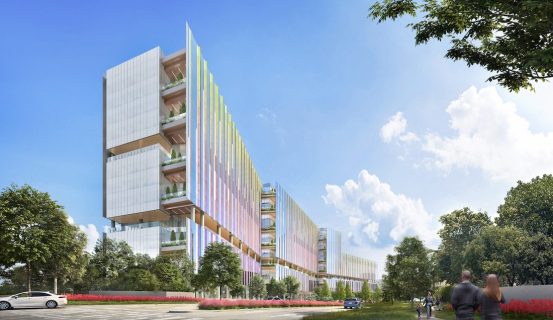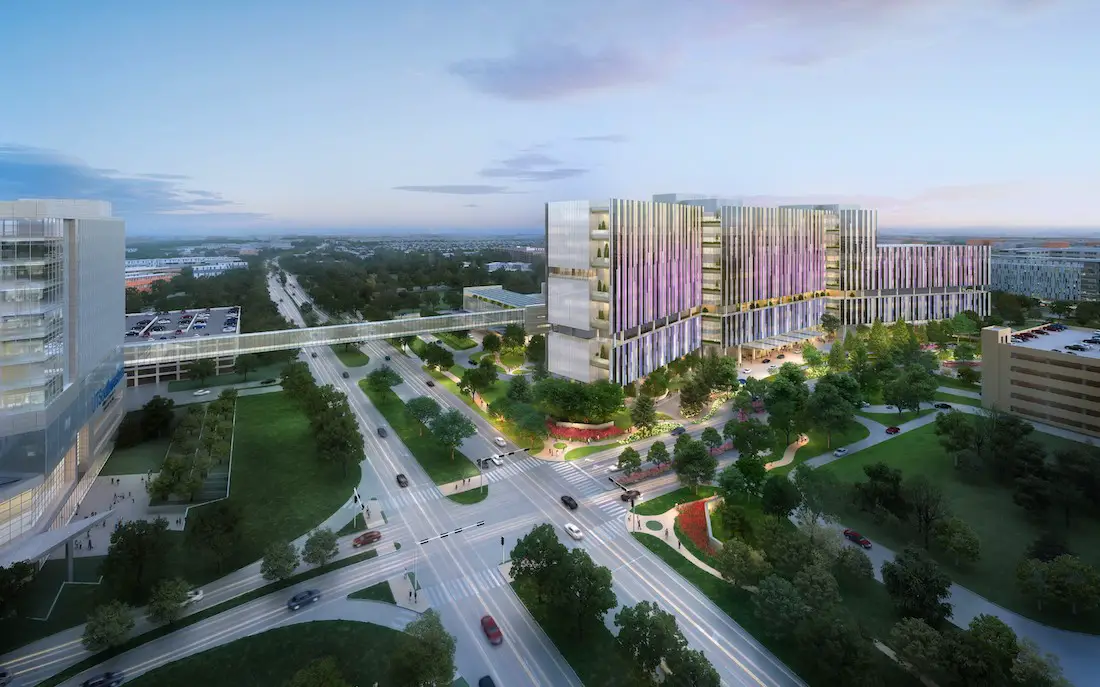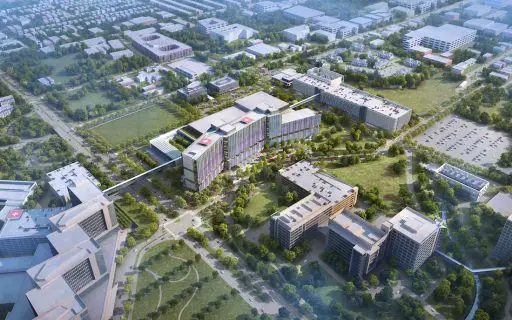Goldman Sachs has pledged philanthropic support to the Moody Children’s Hospital, a $5 billion pediatric hospital campus that UT Southwestern Medical Center and Children’s Health are building in Dallas, marking one of the earliest corporate gifts to the project.
The contribution adds momentum to the joint campus, which began construction in October 2024 and is expected to open in 2031. The development will expand inpatient, surgical, and outpatient capacity for the fast-growing pediatric population in the Dallas–Fort Worth region.
Details of the size of the gift were not disclosed. UT Southwestern and Children’s Health said the funding will support work on the more than 4.9-million-square-foot complex, which will include Moody Children’s Hospital and 552 beds across three towers.
Goldman Sachs has been increasing its footprint in North Texas, including construction of an 800,000-square-foot office campus in Uptown. The firm now employs more than 4,500 people in the region, its largest U.S. workforce outside New York.
Rob Kaplan, Vice Chairman of Goldman Sachs and a member of UT Southwestern’s President’s Advisory Board, said the company is supporting the project as part of its civic involvement in the area. Aasem Khalil, head of Goldman Sachs’ Dallas office and incoming chair of the UT Southwestern President’s Advisory Board, said the hospital campus reflects the scale of development drawing the firm to Dallas.
Hospital leaders said the campus is intended to meet rising demand for pediatric services as the region’s population continues to expand. They emphasized that the facility will also serve as a training and research hub for future health-care providers. This project is one of the key healthcare construction projects in the U.S.

New Pediatric Hospital Campus – Dallas, Texas
Project Overview
UT Southwestern Medical Center and Children’s Health are jointly developing a $5 billion pediatric hospital campus in Dallas to address growing demand for children’s health services in the Dallas–Fort Worth region.
Key Facts
Size: 4.9+ million square feet
Capacity: 552 beds across three towers
Construction Start: October 2024
Expected Opening: 2031
Facility: Moody Children’s Hospital
Project Scope
Expanded inpatient capacity
Enhanced surgical facilities
Increased outpatient services
Training hub for healthcare providers
Research facilities
On February 7, 2024. Children’s Health and UT Southwestern Medical Center unveiled their plan for a $5 billion pediatric health campus in Dallas’ Southwestern Medical District. Spanning more than 33 acres, the campus is designed with a patient-centered layout to meet growing demand across routine and highly specialized pediatric services. The project will also serve as a hub for innovation, academic research, and training, with a goal of developing life-saving technologies and improving care for children.
The pediatric hospital, now under construction, will replace the existing Children’s Medical Center Dallas. It will include two 12-story towers and one 8-story tower. The campus aims to increase capacity for inpatient, surgical, and outpatient services in one of the fastest-growing metropolitan regions in the U.S. Construction began with a groundbreaking on October 1, 2024, and the hospital is slated to open in 2031. The site is located at the corner of Harry Hines Boulevard and Mockingbird Lane, directly across from UT Southwestern’s William P. Clements Jr. University Hospital.
Read also: Rusk State Hospital opens in Texas
The new pediatric campus project in Dallas: Key features and details
The new pediatric campus in Dallas project encompasses 5 million feet of construction including an increase of 552 beds (a rise of 38%) and provisions, for future expansion. It also entails the expansion of the Emergency Department by 15% and operating rooms by 22%. Noteworthy features comprise two helicopter pads and the establishment of a Level I pediatric trauma center. Additionally, it will include 90 examination rooms and 24 observation rooms in the Emergency Department. An essential aspect is the creation of a connector bridge connecting the campus with Clements University Hospital ensuring seamless care continuity. This connection will be particularly beneficial for infants who require access to care at the Level IV Neonatal Intensive Care Unit (NICU) and Cardiovascular Intensive Care Unit (CVICU).
Read also: Houston Methodist Hospital expansion project reaches completion

Furthermore, as part of this new pediatric campus in Dallas, a state-of-the-art fetal care center will be developed to cater to maternal and fetal healthcare needs. The center will have facilities such as surgery capabilities at Clements University Hospital. In addition to that, there are plans for an outpatient clinic building that will augment existing facilities. This new building will add 96 examination rooms to supplement the operational 344 exam rooms at Children’s Health Specialty Center Dallas outpatient facility on Stemmons Freeway, at Medical District Drive.
The opening date for the new pediatric campus in Dallas is planned for 2031.
At the unveiling, Children’s Health CEO Christopher Durovich said the organization has spent more than a century adapting to the region’s growing pediatric needs. He said the new joint campus with UT Southwestern will expand their ability to treat children across all levels of medical complexity while advancing research, new treatments, and technology for future generations.
Read also: Construction of the New North Texas State Hospital is set to begin
Both organizations state that the Dallas Fort Worth area is experiencing a growing need, for healthcare services because its population growth consistently surpasses the average. By 2025 it is estimated that, around 8.5 million people will call this area their home. Currently 2.5 million individuals reside in the Dallas Fort Worth region. It is predicted that this number will surpass three million by 2032. Furthermore by the year 2050 the population is expected to double.


